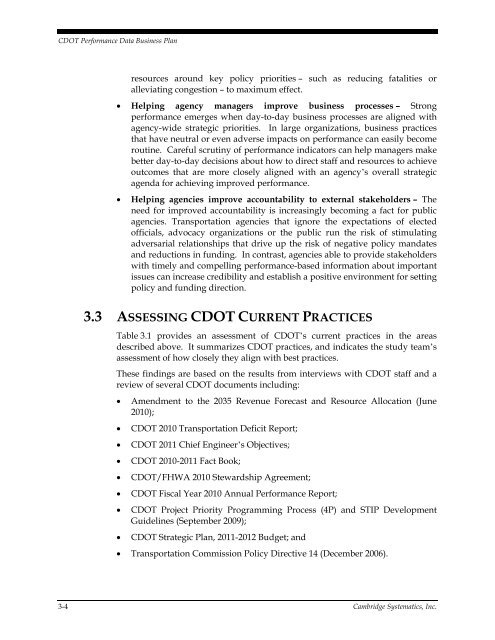CDOT Performance Data Business Plan - Cambridge Systematics
CDOT Performance Data Business Plan - Cambridge Systematics
CDOT Performance Data Business Plan - Cambridge Systematics
Create successful ePaper yourself
Turn your PDF publications into a flip-book with our unique Google optimized e-Paper software.
<strong>CDOT</strong> <strong>Performance</strong> <strong>Data</strong> <strong>Business</strong> <strong>Plan</strong><br />
resources around key policy priorities – such as reducing fatalities or<br />
alleviating congestion – to maximum effect.<br />
Helping agency managers improve business processes – Strong<br />
performance emerges when day-to-day business processes are aligned with<br />
agency-wide strategic priorities. In large organizations, business practices<br />
that have neutral or even adverse impacts on performance can easily become<br />
routine. Careful scrutiny of performance indicators can help managers make<br />
better day-to-day decisions about how to direct staff and resources to achieve<br />
outcomes that are more closely aligned with an agency’s overall strategic<br />
agenda for achieving improved performance.<br />
<br />
Helping agencies improve accountability to external stakeholders – The<br />
need for improved accountability is increasingly becoming a fact for public<br />
agencies. Transportation agencies that ignore the expectations of elected<br />
officials, advocacy organizations or the public run the risk of stimulating<br />
adversarial relationships that drive up the risk of negative policy mandates<br />
and reductions in funding. In contrast, agencies able to provide stakeholders<br />
with timely and compelling performance-based information about important<br />
issues can increase credibility and establish a positive environment for setting<br />
policy and funding direction.<br />
3.3 ASSESSING <strong>CDOT</strong> CURRENT PRACTICES<br />
Table 3.1 provides an assessment of <strong>CDOT</strong>’s current practices in the areas<br />
described above. It summarizes <strong>CDOT</strong> practices, and indicates the study team’s<br />
assessment of how closely they align with best practices.<br />
These findings are based on the results from interviews with <strong>CDOT</strong> staff and a<br />
review of several <strong>CDOT</strong> documents including:<br />
<br />
<br />
<br />
<br />
<br />
<br />
<br />
<br />
Amendment to the 2035 Revenue Forecast and Resource Allocation (June<br />
2010);<br />
<strong>CDOT</strong> 2010 Transportation Deficit Report;<br />
<strong>CDOT</strong> 2011 Chief Engineer’s Objectives;<br />
<strong>CDOT</strong> 2010-2011 Fact Book;<br />
<strong>CDOT</strong>/FHWA 2010 Stewardship Agreement;<br />
<strong>CDOT</strong> Fiscal Year 2010 Annual <strong>Performance</strong> Report;<br />
<strong>CDOT</strong> Project Priority Programming Process (4P) and STIP Development<br />
Guidelines (September 2009);<br />
<strong>CDOT</strong> Strategic <strong>Plan</strong>, 2011-2012 Budget; and<br />
Transportation Commission Policy Directive 14 (December 2006).<br />
3-4 <strong>Cambridge</strong> <strong>Systematics</strong>, Inc.

















